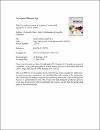Search
Now showing items 1-10 of 41
Microalgal nutrients recycling from the primary effluent of municipal wastewater and use of the produced biomass as bio-fertilizer
(
Center for Environmental and Energy Research and Studies
, 2019 , Article)
Availability of N, P and other trace metals in municipal wastewater (MWW) makes it very attractive to produce microalgae biomass using MWW. Although limited organic carbon is available in MWW, supplementing flue gas as CO2 ...
Delineating the plastic waste status in the State of Qatar: Potential opportunities, recovery and recycling routes.
(
Elsevier
, 2019 , Article)
The Qatar's national vision (QNV2030) underlines an unequivocal commitment to maintaining harmony between the three inter-dependent pillars of sustainable development: economic growth, social development and environmental ...
Assessment of the algae-based biofertilizer influence on date palm (Phoenix dactylifera L.) cultivation
(
Springer Netherlands
, 2019 , Article)
Date palm (Phoenix dactylifera L.) is the main fruit crop found in the arid and semi-arid regions of the world. It naturally adapts to the adverse environments of extreme heat and water scarcity and prevents further ...
Comparison between Thermo-Alkaline and Electro-Fenton Disintegration Effect on Waste Activated Sludge Anaerobic Digestion
(
Hindawi Limited
, 2019 , Article)
Disintegration of municipal waste activated sludge (WAS) using thermo-alkaline (TA) and electro-Fenton (EF) methods was investigated and compared in terms of the efficiency of sludge solubilisation and enhancement of ...
An overview of the plastic waste and recycling status in Qatar
(2019 , Conference Paper)
It has been estimated that the average Municipal Solid Waste (MSW) generation rate per capita in the Gulf Co-operation countries (GCC) is approx. 1.5 kg/person/d, with Qatar reaching almost 1.4 kg/person/d, as it was ...
An overview of the challenges and trade-offs in closing the loop of post-consumer plastic waste (PCPW): Focus on recycling
(
Elsevier
, 2019 , Article)
© 2019 Elsevier B.V. Recycling of post-consumer plastic waste (PCPW) is increasingly promoted as the means to achieving circular economy (CE). It converts plastic waste into a secondary material that can be fed back into ...
Use and assessment of “e-plastics” as recycled aggregates in cement mortar
(
Elsevier
, 2019 , Article)
© 2019 Elsevier B.V. In this study we investigated the physical and mechanical properties of cement mortars, partially replaced with plastic (recycled plastic aggregate, RPA) recovered from WEEE (namely, “e-plastics”). The ...
Solar energy farming as a development innovation for vulnerable water basins
(
Routledge
, 2019 , Article)
In vulnerable water basins, unregulated access to solar energy and groundwater can threaten water security through increased abstractions. Public and development agencies are therefore exploring options to provide farmers ...
Participation modes and diplomacy of Gulf Cooperation Council (GCC) countries towards the global sustainability agenda
(
Routledge
, 2019 , Article)
After decades of reluctance, the Gulf Cooperation Council (GCC) countries are now more engaged within the global sustainability agenda. Though they historically sought to coordinate strategies, differences in environmental ...
Comparative scorecard assessment of urban water pricing policies-The case of Jordan and Iran
(
MDPI AG
, 2019 , Article)
Urban water pricing is becoming increasingly important due to the rapid rate of urbanization and the expansion of water reclamation and reuse. The mounting evidence of failures of current pricing schemes makes analyzing ...






